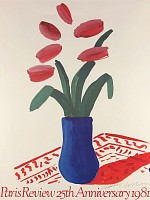BIOGRAPHY

David Hockney (British b. 1937)
One of the foremost painters, designers, and photographers of the 20th-century contemporary art scene in the United States and England, David Hockney was born in Bradford, Yorkshire, England. He experimented with numerous styles including that of 15th-Century Italian master, Piero della Francesca and with a variety of subject matter including portraits and other depictions of family and people he met in his extensive travels.
He studied at Bradford College of Art in 1957, and in 1962 at the Royal College of Art. In the 1960s, much of his work was a homage to his heroes that included Picasso, Dubuffet, and Matisse, and in style was much influenced by Abstract Expressionism*. In the mid 1970s, he spent three years in Paris and then traveled to Los Angeles, where he did a series of lithographs* and also did his first opera design, which was for Stravinsky's The Rake's Progress. In 1988, the University of Aberdeen, Scotland, awarded him an honorary doctorate.
One of his closest friends in New York City was Metropolitan Art Museum curator and leading art commentator, Henry Gedzhaler, with whom he traveled extensively in the 1970s and 1980s. Hockney did numerous paintings, lithographs and drawings that included Gedzhaler.
He has had numerous one-man shows including at the Kasmin Gallery, 1963-1989; in New York at the Museum of Modern Art in 1964 and the Metropolitan Museum of Art in 1988; the Stedelijk Museum in Amsterdam, Holland in 1966; and the Tate Gallery in London in 1988. He has also been a stage set designer for the Metropolitan Opera in New York City.
Hockney has lectured at universities including the University of Iowa in 1964, the University of Colorado in 1965, the University of California in Los Angeles in 1966, and the University of California-Berkeley in 1967.
In 1998, he did a series of vivid pastels on the Grand Canyon called David Hockney: Space & Line, that were exhibited in Paris at Centre George Pompidou from January 27 to April 26th, 1999, and following that for a month at the Richard Gray Gallery in New York City.
The paintings are large-scale, impressionist* close-ups of the Canyon in the morning light. In 1999, he won the Wollaston award for some of his Canyon paintings, which were exhibited at London's Royal Academy of Arts*.
In 2001, Hockney's book, Secret Knowledge, was published by Viking Press and stirred much discussion with his assertion that many of the Old Masters* including Vermeer, Rembrandt, and Durer frequently used optical devices to achieve their near perfect realism*. His theory is that the mirror, the "camera obscura"*, and the "camera lucida"* were widely used by artists as early as the 1400s and that the introduction of photography in the 19th century freed artists from realism.
